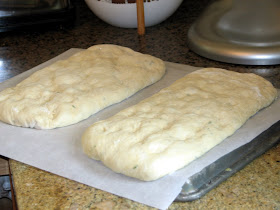
This bread was as flavorful and satisfying as last week's was dull and disappointing. It's from Maggie Glezer's Artisan Baking, which is one of the three bread books that I find both consistently good and very readable. (The other two are Carol Field's The Italian Baker and, of course The Bread Bible). The recipe is adapted from The Acme Bread Company in Berkeley. (When Elizabeth was visiting colleges, we went to Berkeley--how I wish I'd known about this bakery then! Someday I hope to take a cross-country trip, visiting all the iconic bakeries in the country). But back to the bread.
It's a very easy bread, but it does take time. You must start it on Friday night to have it ready for Saturday dinner because, although no step is difficult, there is only a very modest amount of yeast in the bread, so its risings are slow. The poolish is made with only 1/4 teaspoon of instant yeast, which is mixed in a cup of water. Only 1/4 cup of this yeast water is used, so the poolish really has only about 1/16 teaspoon of yeast. After 12 hours, however, it is bubbling satisfactorily.

In the morning, or 12 hours later, the poolish is mixed with a little more yeast, flour, chopped rosemary, water, and olive oil. It's a very soft, sticky dough, which is folded three times in the first hour.

After its third folding, the dough is a little more tractable. It can then be left alone for another five hours. Yes, seriously--five hours. While it's sitting in its big bowl, you can go out in your garden and start planting flowers, eat lunch, finish the Saturday crossword, and do some laundry. Eventually the dough doubles in size. Then you cut it in half and let it rest for a while (because it's been working so hard the last six hours). After that, you shape them into rectangles and put them into a couche (or a makeshift couche) for another hour and a half.

And you are still not done because they need to be shaped into a 12 x 6-inch rectangle, dimpled all over, and let them proof for yet another two hours.

If you are a fussy, obsessive person, you will get out your tape measure and make sure they are really 12 inches by six inches. Otherwise, you'll guess.

The only thing I had a problem with was flipping them over after five minutes of baking. They're on the next-to-the-top shelf of the oven, which is quite high in my oven, and the oven is very hot. The flipping process did not go smoothly and one of the loaves ended up scarred. But such scars can be hidden, and when the bread is sliced, no one will notice.

The texture is attractive and the flavor is quite toothsome.

That's a little piece of rosemary you see in the picture, by the way, not mold.
Much as I enjoyed this bread, I thought it came up a bit short if compared to Rose's rosemary focaccia, which has the added flavor elements of olive oil and sea salt on top. But if you don't compare it to an old favorite, it's quite enjoyable.
ACME'S HERB SLABS
--from Artisan Baking, by Maggie Glezer
Poolish
1/4 tsp. instant yeast
1 c. water, 110 to 115 degrees F.
2 cups (300 grams)unbleached all-purpose flour
1 1/3 cups (295 grams) water
Whisk the yeast into the cup of water and let stand for 5 minutes. Add 1/4 cup of the yeasted water to the flour, then beat in the lukewarm water. Cover with plastic wrap and let it ferment overnight for about 12 hours.
Dough
3 cups (450 grams) unbleached all-purpose flour
1 Tbsp. (16 grams) salt
4 teaspoons fresh rosemary
1/4 tsp. instant yeast
3/4 cups (170 grams) lulkewarm water
1 Tbsp. (30 grams) olive oil.
By stand mixer: Combine the flour, salt, rosemary, and yeast in the mixing bowl. Add the water and oil to the poolish, and pour into the flour mixture. Mix with dough hook on low speed until rough dough forms. Cover the bowl and let rest for 10 minutes. Mix the dough another five minutes, until very smooth.
Place the dough in large oiled container and cover with plastic wrap. Let dough ferment until doubled in bulk, about six hours. Turn the dough 3 times during the first hour of proofing.
Cut the dough in half. Round the pieces and let rest for 20 minutes. Press dough into rectangle. Fold into thirds like a business letter, place seam side down in couche and cover with a flap of the couche. Repeat with other piece of dough. Let them proof for about 1 1/2 hours.
Cover a large baking sheet with parchment paper. Press each piece into a 12 x 6-inch rectangle. Press your fingertips into the dough to dimple all over. Move the dougoh onto the parchment paper and reshape. Cover with plastic wrap and let proof another two hours.
Place race on oven's second to top shelf and place a baking stone on it. Preheat oven to 450 degrees F.
Poke the dough all over with a skewer. Slip the breads, still on the parchment, onto the hot stone and bake for five minutes. Flip the breads over onto the stone and remove the paper. Continue baking until they are well browned, about 20 minutes more, rotating them after 10 minutes. Let the breads cool on a rack.









